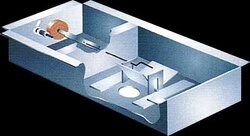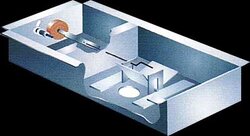Frank Ivy said:
Wrong -
Sweep wrote: "As to how the device increases burn time by sometimes adding air, it only adds air when the manual draft is set too low to supply adequate combution air to sustain secondary lightoff temperatures, "
No. It functions entirely independently of the draft lever.
When the coil gets hot, it opens. When the coil gets cold, it closes. That simple.
So, Sweep, what you are saying is that the "Extended Burn Technology" adds air when the fire "needs it", which of course would shorten the burn.
If you are correct, then the device is misnamed.
Frank, the EBT functions independently of the manual draft lever, but it is the setting of the manual draft lever (specifically the low burn setting) that creates the temperature change in the firebox that brings the EBT mechanism into play. If you keep the manual draft control open enough to sustain secondary combustion temperatures, the EBT won't open up to supply supplemental air.
Your statement that when the coil gets hot the EBT opens and when the coil gets cold it closes isn't accurate. When the stove is cold, the EBT is closed. As the stove heats up, it opens gradually until lightoff temperature is achieved. If the stove starts to overheat, it closes gradually until the temperature returns to a safe level.
As to your contention that adding supplemental air at certain times shortens the burn time, either you haven't been reading my posts very carefully, or I haven't been doing a good job explaining things (which I'll admit is quite likely). So I'll try again.
Let's say you want to build a stove that achieves the maximum possible burn time for its firebox size. You could weld up an airtight firebox with a tight sealing door, and incorporate a draft control that could shut down the flow of combustion air all the way. Then, to achieve the ultimate burn time, you could get your fire kindled up and slam the draft control all the way shut, cracking it open just enough to keep the fire smoldering along. You'd get incredibly long burn times for each load of fuel, but the unburned exhaust gases would billow out the chimney at criminal levels.
If you did that, you'd achieve the longest possible burn, but you wouldn't be able to sell your stove in the US due to the EPA emissions regulations.
So let's say you want to build a stove without the EBT technology, and want it to achieve the longest possible burn without creating unacceptable emissions levels (like today's manufacturers must do). You could insert a temperature probe into the stove, load and kindle your fire, and wait until lightoff temperature was reached. Then, to achieve your long burn, you could crank the manual draft control down to its lowest setting. Then, you could monitor the secondary combustion temperature and, if it started to fall below lightoff level, crank the manual draft open a bit to supply more air until the temperature came back up to lightoff level, then tweak the draft back down for the long burn, repeating these moves as necessary throughout the second stage of your burn. Because the fire would change character throughout the burn, you wouldn't be able to stop tweaking the air supply until charcoal stage was reached and you could set the manual draft to low for the duration.
If you did that, you would have achieved the longest possible EPA approved burn, giving the fire just enough air to stay clean-burning but no extra air to shorten the burn time.
And that's exactly what the EBT mechanism does.




